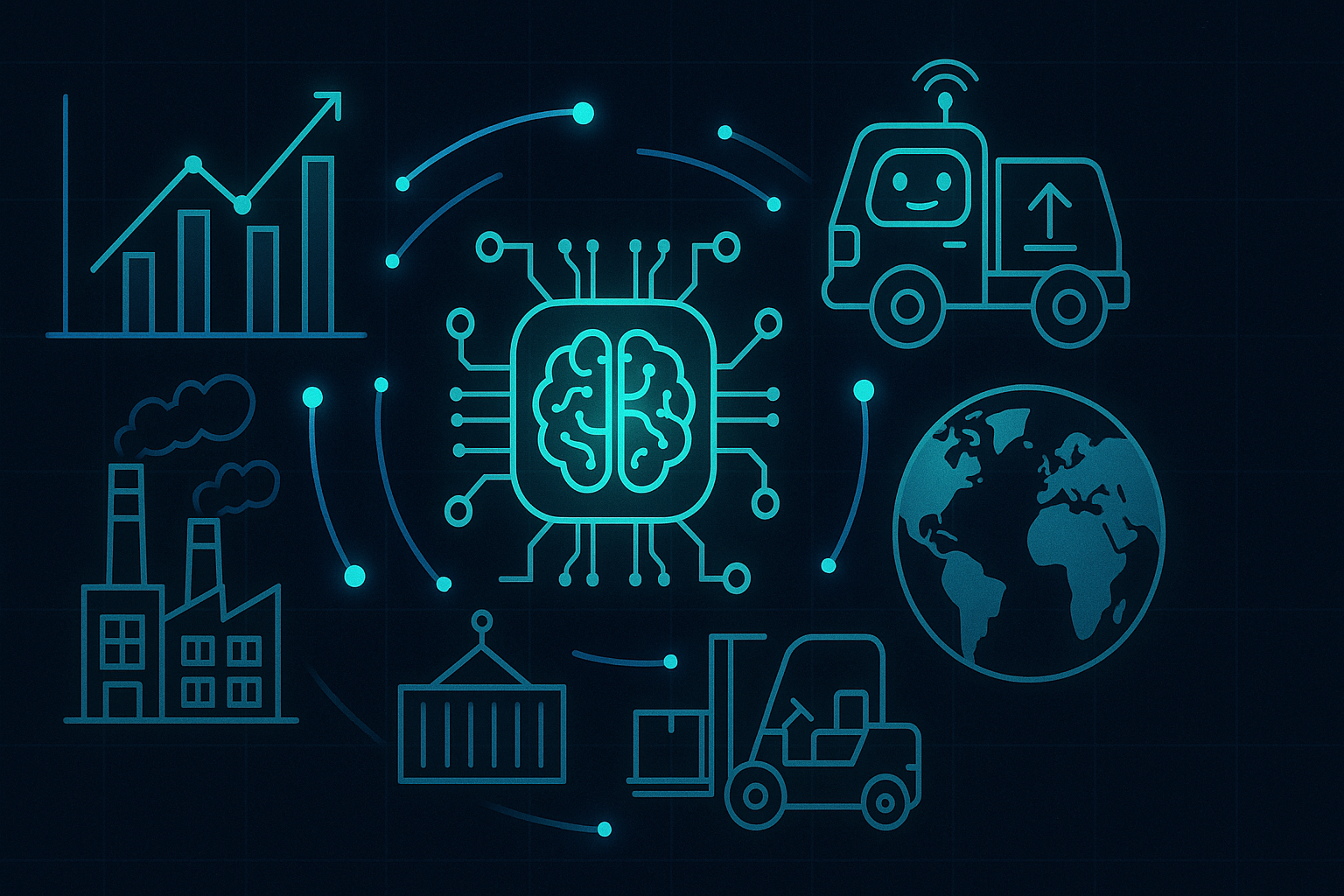Beyond Efficiency: The New AI Supply Chain Advantage
For decades, supply chains were optimized for efficiency. faster deliveries, cheaper labor, and leaner inventories. But in today’s volatile, interconnected world, efficiency alone is no longer enough. Resilience, adaptability, and real-time intelligence have become the new imperatives. And that’s exactly where artificial intelligence is stepping in.
AI is not just automating old processes. It is fundamentally redefining how supply chains operate. From demand forecasting and inventory optimization to autonomous logistics and predictive risk management, AI-powered systems are turning linear, reactive supply chains into dynamic, data-driven ecosystems.
What once took weeks of manual planning can now happen in minutes. What once required teams of analysts can now be handled by algorithms trained on millions of data points. This is not just about doing things faster. It is about doing them smarter.
In this article, we will explore how AI is revolutionizing every link in the supply chain. and why forward-looking companies are not just adopting these technologies. They are reengineering their entire supply strategies around them.
Forecasting That Actually Works
Traditional demand forecasting is often more guesswork than science, reliant on historical data, manual inputs, and optimistic assumptions. The result? Overstocked warehouses, empty shelves, and reactive supply chain chaos. But AI is rewriting the rules, transforming forecasting from a static exercise into a living, adaptive system.
Machine learning algorithms can analyze years of sales history, market conditions, weather patterns, social sentiment, and real-time data feeds to predict future demand with astonishing accuracy. And unlike humans, these systems learn and improve continuously. The more data they ingest, the better they get. identifying trends, seasonality, and even anomalies that would go unnoticed by conventional models.
AI does not just produce a number. It delivers dynamic forecasts that adjust in real time. If a viral TikTok trend suddenly spikes demand, or if a regional event disrupts supply, AI systems can detect the shift instantly and update forecasts accordingly. This responsiveness helps businesses stay ahead of the curve instead of constantly chasing it.
For supply chain leaders, this is not just about optimization. It is about competitive edge. Accurate forecasting means leaner inventories, fewer stockouts, and faster response times. And in a world where agility beats scale, that is the kind of advantage no business can afford to ignore.
Inventory That Thinks Ahead
Inventory management has long been a balancing act between stockouts and overstock. Too little, and you lose sales; too much, and you lose capital. Traditional systems rely on rigid rules, historical averages, and human judgment. But AI introduces a new paradigm: adaptive, intelligent inventory that continuously learns and adjusts in real time.
AI algorithms digest an enormous range of inputs, historical sales, seasonality, supplier lead times, regional preferences, promotional calendars, even weather patterns, to optimize inventory levels across locations. The result is not just more efficient stocking. It is smarter stocking, tuned to actual demand signals and responsive to change.
What sets AI-driven inventory apart is its dynamic nature. These systems do not wait for humans to notice anomalies or run monthly reports. They flag discrepancies the moment they emerge. If a product starts flying off the shelves in one region, AI shifts stock accordingly. If supply delays are expected, it recommends preemptive ordering. The system becomes a real-time decision engine, not just a tracker.
By minimizing holding costs while maximizing availability, AI does not just trim the fat. It builds a leaner, faster, more agile supply chain. And in today’s environment of uncertainty and disruption, that kind of adaptability is priceless.
Logistics, But Smarter
Logistics has always been a complex, high-stakes game. one that involves juggling routes, fleets, fuel costs, delays, regulations, and customer expectations. Traditionally, it has been reactive: when something breaks, reroute. When traffic builds, delay. But AI is flipping the model. making logistics predictive, autonomous, and astonishingly efficient.
With AI, routing becomes intelligent. Algorithms analyze real-time traffic, weather, delivery windows, fuel prices, and road restrictions to optimize delivery paths not once a day, but constantly. The goal is not just the fastest route. It is the smartest one, balancing cost, time, risk, and even environmental impact.
Autonomous logistics takes this further. Drones, self-driving delivery vehicles, and robotic warehouse systems are no longer science fiction. AI manages these systems at scale. coordinating fleets, scheduling movements, and resolving conflicts faster than any human dispatcher. The result is logistics that operates at machine speed. and learns with every delivery.
AI also enhances visibility. Businesses can now track shipments across the globe in real time, predict delays before they happen, and proactively communicate with customers. This does not just reduce costs. It builds trust.
In short, AI is not replacing logistics’ managers. It is giving them superpowers. real-time insight, adaptive planning, and near-autonomous execution. And in a supply chain world where speed and precision rule, that is a game-changer.
Seeing the Storm Before It Hits
Supply chains are inherently vulnerable. to supplier disruptions, equipment failures, political unrest, pandemics, and even climate events. But most companies still operate in reactive mode, addressing problems only after they have erupted. AI offers a smarter alternative: anticipate the storm before it hits.
Predictive analytics enables businesses to foresee disruptions in their supply network with impressive precision. By analyzing historical patterns, weather data, geopolitical trends, sensor inputs, and third-party alerts, AI can flag potential risks. from delayed shipments and factory outages to supplier insolvencies. long before they impact operations.
But prediction is just the beginning. AI systems also simulate scenarios and suggest contingency plans. If a supplier in Southeast Asia is hit by a typhoon, the AI might recommend rerouting orders to an alternative source. not after the event, but in advance. If warehouse machinery shows signs of strain, predictive maintenance tools can schedule repairs before it fails.
This proactive risk management is not just about minimizing losses. It is about preserving continuity, protecting brand reputation, and maintaining customer trust. In an era where even minor delays can cascade across global networks, the ability to see and act early is nothing short of a strategic necessity.
AI does not eliminate uncertainty. But it arms businesses with the foresight and flexibility to outmaneuver it.
Why AI is the Future of Strategic Supply Chains
For decades, supply chains were seen as cost centers, back-end functions focused on efficiency and fulfillment. But AI is changing the narrative. Today’s smartest companies are treating supply chains as strategic assets, and AI as their engine for transformation.
AI does not just improve operational metrics. It reshapes how companies compete. It enables faster pivots, smarter procurement, tighter alignment between demand and production, and deeper customer insight. In short, it turns the supply chain from a support function into a source of differentiation.
What makes AI indispensable is not just its power. It is its adaptability. Whether you are managing a global logistics network or a regional distribution center, AI scales to fit. It integrates with legacy systems, pulls from disparate data sources, and learns as it goes. It does not ask you to reinvent the wheel, just let the wheel think for itself.
Leaders who embrace AI do not just make their supply chains more efficient. They make their businesses more resilient, responsive, and future-ready. And in an era defined by uncertainty, that readiness is no longer optional. It’s survival.
AI is not a plug-in. It is a paradigm shift. And the companies that move first, building intelligence into the core of their supply chains, will be the ones who set the pace, not follow it.
Ressources
- Iaeme Pub – AI‑Powered Supply Chain Innovation: From Predictive Analytics to Warehouse Automation
- DataCamp – AI in Supply Chain: Key Applications and Benefits
- Ryder – AI For Supply Chain Optimization: Predictive Maintenance
- Analytics at H‑in‑Q



